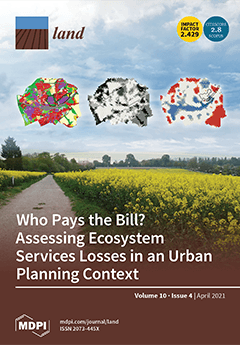This research was focused on estimation of tree canopy cover (CC) by multiscale remote sensing in south China. The key aim is to establish the relationship between CC and woody NDVI (NDVI
W) or to build a CC-NDVI
W model taking northeast Jiangxi as an example. Based on field CC measurements, this research used Google Earth as a complementary source to measure CC. In total, 63 sample plots of CC were created, among which 45 were applied for modeling and the remaining 18 were employed for verification. In order to ascertain the ratio R of NDVI
W to the satellite observed NDVI, a 20-year time-series MODIS NDVI dataset was utilized for decomposition to obtain the NDVI
W component, and then the ratio R was calculated with the equation R = (NDVI
W/NDVI) *100%, respectively, for forest (CC > 60%), medium woodland (CC = 25–60%) and sparse woodland (CC 1–25%). Landsat TM and OLI images that had been orthorectified by the provider USGS were atmospherically corrected using the COST model and used to derive NDVI
L. R was multiplied for the NDVI
L image to extract the woody NDVI (NDVI
WL) from Landsat data for each of these plots. The 45 plots of CC data were linearly fitted to the NDVI
WL, and a model with CC = 103.843 NDVI
W + 6.157 (R
2 = 0.881) was obtained. This equation was applied to predict CC at the 18 verification plots and a good agreement was found (R
2 = 0.897). This validated CC-NDVI
W model was further applied to the woody NDVI of forest, medium woodland and sparse woodland derived from Landsat data for regional CC estimation. An independent group of 24 measured plots was utilized for validation of the results, and an accuracy of 83.0% was obtained. Thence, the developed model has high predictivity and is suitable for large-scale estimation of CC using high-resolution data.
Full article





